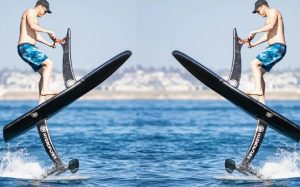How Fast Can an Efoil Go?
The allure of efoiling lies not only in the exhilarating sensation of gliding above the water but also in the remarkable speeds these innovative boards can achieve. As efoils continue to carve a niche in water sports, one of the most frequently asked questions is, "How fast can an efoil go?" This exploration delves into the factors that influence efoil speed, providing a comprehensive look at what riders can expect when they hit the water.

Understanding Efoil Speed Capabilities
At its core, the speed of an efoil is influenced by several key factors including motor power, board design, rider weight, and environmental conditions. On average, efoils can reach speeds ranging from 15 to 35 mph (24 to 56 km/h). This range ensures that both beginners and experienced riders can find a comfortable cruising speed, as well as push their limits for an adrenaline rush.
The Role of Motor Power
The motor is the heartbeat of an efoil, propelling the board forward and lifting it above the water. Most efoils are equipped with electric motors that range from 3,000 to 6,000 watts of power. Higher wattage generally translates to higher potential speeds, allowing advanced models to breach the upper limits of the efoil's speed range.
Board Design and Hydrodynamics
The design of the efoil itself plays a critical role in its speed capabilities. Board size, foil shape, and overall hydrodynamics impact how efficiently an efoil cuts through the water. Smaller, more streamlined boards with optimally designed foils can achieve higher speeds by reducing drag and improving lift.
Rider Weight and Skill Level
Rider weight is another significant factor affecting efoil speed. Heavier riders may find that their efoil doesn't reach the top speeds achievable by lighter individuals due to increased drag and lift requirements. Conversely, skilled riders can maximize their board's speed by optimizing their stance and weight distribution, even if they're on the heavier side.
Environmental Conditions
Lastly, environmental conditions such as water smoothness, wind speed, and current direction can influence how fast an efoil can go. Calm, flat waters are ideal for reaching top speeds, while choppy conditions or strong headwinds can reduce overall velocity.
For those curious about the thrilling speeds efoiling has to offer and looking to explore a selection of high-performance boards, visiting efoil speed provides access to a range of options tailored to diverse skill levels and speed preferences. Whether you're aiming for a leisurely glide or seeking the rush of high-speed cruising, the perfect efoil awaits.
The Need for Speed on Water
In conclusion, the speed of an efoil is a dynamic interplay between technology, design, human skill, and nature. With advancements in efoil technology and a better understanding of hydrodynamics, riders can look forward to even faster and more exhilarating experiences on the water. Whether you're new to the world of efoiling or a seasoned pro, the quest for speed is an integral part of the adventure, offering endless possibilities for exploration and thrill.
